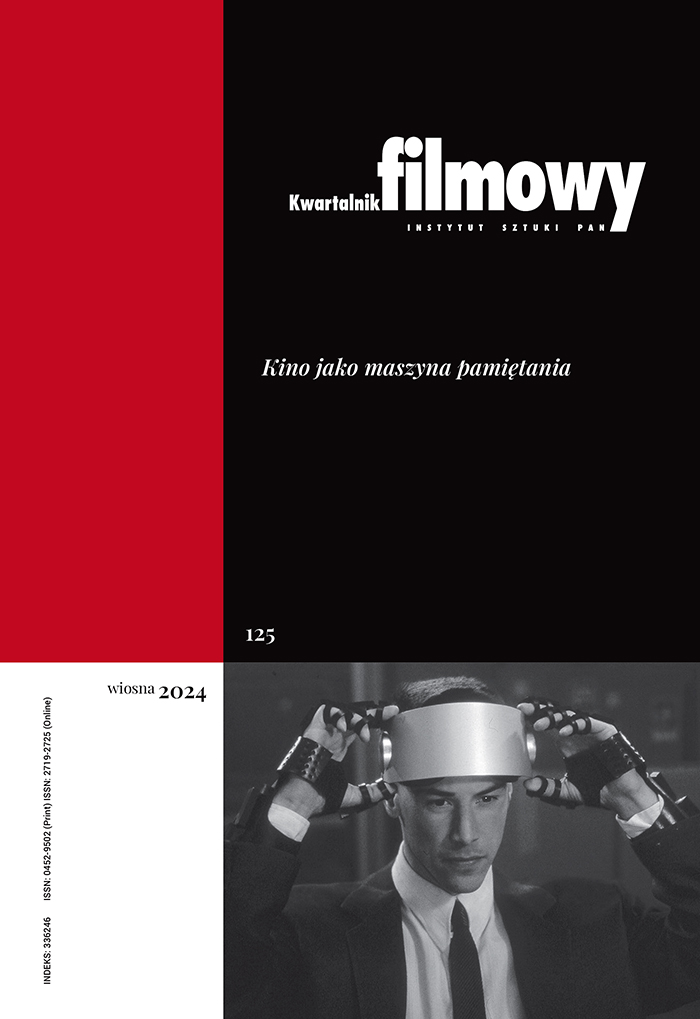O nas bez nas. Postantropocentryczne kinematografie stref wykluczenia
Ewa Wójtowicz
ewa.wojtowicz@uap.edu.plUniwersytet Artystyczny w Poznaniu (Polska)
https://orcid.org/0000-0002-8659-940X
Abstrakt
Tematem tekstu są postantropocentryczne kinematografie stref wykluczenia człowieka powstające za sprawą teoriopraktycznych badań naukowych realizowanych metodami artystycznymi. Przywołane przykłady obejmują działalność Instytutu Strelka (projekty The New Normal i Geocinema), twórczość Emmy Charles, Johna Gerrarda, Evana Rotha, Trevora Paglena i Liama Younga (także w ramach Unknown Field Division) oraz teoretyczne koncepcje tego ostatniego, jak również Benjamina Brattona. Do stref wykluczenia człowieka zalicza się krajobrazy (pejzaże) maszynowe, w tym m.in. centra danych, farmy serwerów, zautomatyzowane miejsca produkcji i wydobycia surowców naturalnych niezbędnych do produkcji współczesnej technologii. Istotny jest także sieciowy obieg obrazów jako danych z pominięciem udziału człowieka (widzenie maszynowe na potrzeby sztucznej inteligencji) oraz dane z globalnych sieci sensorowych. Wszystkie powyższe przykłady zostały omówione w kontekście projektów artystycznych wykorzystujących medium filmu.
Instytucje finansujące
Słowa kluczowe:
postantropocen, strefy wykluczenia człowieka, nowa normalność, geokino, pejzaż maszynowy, technoesencjalizm, ksenoprzestrzeń, infrastruktura, widzenie maszynoweBibliografia
Agamben, G. (2009). „What is an Apparatus?” and Other Essays (tłum. D. Kishik, S. Pedatella). Redwood City: Stanford University Press.
Google Scholar
Bazdyrieva, A., Orlov, A., Suess, S. (2017-2018). Geocinema. https://geocinema.network
Google Scholar
Bratton, B. (2017). The New Normal: Benjamin Bratton on the Language of Hybrids. Arch Daily. https://www.archdaily.com/878427/the-new-normal-benjamin-brat-ton-on-the-language-of-hybrids-strelka-institute-moscow
Google Scholar
Bratton, B. H. (2019). Further Trace: Effects of the Post-Anthropocene. Architectural Design, 1 (89), ss. 14-21. https://doi.org/10.1002/ad.2382
DOI: https://doi.org/10.1002/ad.2382
Google Scholar
Bridle, J. (2018). New Dark Age: Technology and the End of the Future. London: Verso.
Google Scholar
Burrington, I. (2016). Networks of New York: An Illustrated Field Guide to Urban Internet Infrastructure. Brooklyn: Melville House.
Google Scholar
Conover, T. (2011). Szlaki człowieka. Podróże drogami świata (tłum. P. Schreiber). Wołowiec: Czarne.
Google Scholar
Eisenstein, C. (2020, marzec). The Coronation. https://charleseisenstein.org/essays/the-coronation/
Google Scholar
El-Erian, M. A. (2010). Navigating the New Normal in Industrial Countries. Washington: Per Jacobsson Foundation – International Monetary Fund.
Google Scholar
Ellis, W. (2012, 5 lutego). Robot Readable World. http://www.warrenellis.com/robot-readable-world/
Google Scholar
Foster, H. (2012). Powrót realnego. Awangarda u schyłku XX wieku (tłum. M. Borowski, M. Sugiera). Kraków: Universitas.
Google Scholar
Groen, L., Kuijpers, M. (2020, 3 marca). Automated Landscapes and the Human Dream of Relentlessness. Strelka Mag. https://strelkamag.com/en/article/reporting-from-automated-landscapes
Google Scholar
Hodson, H. (2015, 22 lipca). Follow the Lithium Dreams Expedition to Chile and Bolivia. New Scientist. https://www.newscientist.com/article/2051639-follow-the-lithium-dreams-expedition-to-chile-and-bolivia/
Google Scholar
Hu, T.-H. (2015). A Prehistory of the Cloud. Cambridge: The MIT Press.
DOI: https://doi.org/10.7551/mitpress/9780262029513.001.0001
Google Scholar
Lefebvre, H. (2010). The Production of Space (tłum. D. Nicholson-Smith). Malden – Oxford – Carlton: Blackwell Publishing.
Google Scholar
McNiff, S. (red.) (2013). Art as Research: Opportunities and Challenges. Bristol: Intellect.
Google Scholar
Miller, G. (2019, 15 października). The Pioneering Maps of Alexander von Humboldt. Smithsonian Magazine. https://www.smithsonianmag.com/history/pioneering-maps-alexander-von-humboldt-180973342/
Google Scholar
Morton, T. (2013). Hyperobjects: Philosophy and Ecology after the End of the World. Minneapolis: University of Minnesota Press.
Google Scholar
Paglen, T. (2019). Invisible Images: Your Pictures Are Looking at You. Architectural Design, 1 (89), ss. 22-27. https://doi.org/10.1002/ad.2383
DOI: https://doi.org/10.1002/ad.2383
Google Scholar
Roth, E. (2018-2020). Red Lines. http://redlines.network
Google Scholar
Wiertow, D. (1976). Człowiek z kamerą. Wybór pism (tłum. T. Karpowski). Warszawa: Wydawnictwa Artystyczne i Filmowe.
Google Scholar
Wójtowicz, E. (2019). Materialna chmura. Technoesencjalizm w sztuce mediów. Czas Kultury, 2 (201), ss. 7-13.
Google Scholar
Wójtowicz, E. (2020). „Geokino” jako model widzenia ksenoprzestrzeni. Zeszyty Artystyczne, 1 (37), ss. 35-44.
Google Scholar
Young, L. (2019). Neo-Machine: Architecture Without People. Architectural Design, 1 (89), ss. 6-13. https://doi.org/10.1002/ad.2381
DOI: https://doi.org/10.1002/ad.2381
Google Scholar
Zolotoev, T. (2019, 29 marca). Landscapes of the Post-Anthropocene: Liam Young on Architecture Without People. Strelka Mag. https://strelkamag.com/en/article/landscapes-of-the-post-anthropocene-liam-young-on-architecture-without-people
Google Scholar
Autorzy
Ewa Wójtowiczewa.wojtowicz@uap.edu.pl
Uniwersytet Artystyczny w Poznaniu Polska
https://orcid.org/0000-0002-8659-940X
Doktor habilitowana w zakresie nauk o sztuce (Uniwersytet Jagielloński), doktor nauk humanistycznych (Uniwersytet im. Adama Mickiewicza w Poznaniu), absolwentka Akademii Sztuk Pięknych w Poznaniu. Autorka książek Net art (2008) i Sztuka w kulturze postmedialnej (2016) oraz tekstów naukowych i krytycznych dotyczących sztuki współczesnej, w tym sztuk medialnych. Profesor na Wydziale Edukacji Artystycznej i Kuratorstwa Uniwersytetu Artystycznego w Poznaniu. Należy do Polskiego Towarzystwa Kulturoznawczego, Polskiego Towarzystwa Estetycznego, Polskiego Towarzystwa Badań nad Filmem i Mediami oraz do polskiej sekcji AICA. Zastępca redaktor naczelnej „Zeszytów Artystycznych”. Zainteresowania naukowe: sztuka wobec Internetu i (nowych) mediów.
Statystyki
Abstract views: 729PDF downloads: 576
Licencja
Prawa autorskie (c) 2020 Ewa Wójtowicz

Utwór dostępny jest na licencji Creative Commons Uznanie autorstwa – Użycie niekomercyjne – Bez utworów zależnych 4.0 Międzynarodowe.
Autor bądź autorka udziela wydawcy niewyłącznej i nieodpłatnej licencji (CC BY 4.0) na wykorzystanie tekstu w „Kwartalniku Filmowym”, zachowuje nieograniczone prawa autorskie i zobowiązuje się do podawania miejsca pierwodruku przy ponownym wykorzystaniu artykułu (umowa licencyjna do pobrania). Czasopismo jest wydawane na licencji CC BY 4.0. Zgłaszając artykuł do publikacji, autor bądź autorka wyraża zgodę na jego udostępnianie na tej licencji.
W wydaniach od 105-106 (2019) do 119 (2022) wszystkie artykuły były publikowane na licencji CC BY-NC-ND 4.0. W tym okresie autorzy i autorki udzielali(-ły) niewyłącznej i nieodpłatnej licencji (CC BY-ND 4.0) na wykorzystanie tekstu w „Kwartalniku Filmowym”, zachowywali(-ły) nieograniczone prawa autorskie i zobowiązywali(-ły) się do podawania miejsca pierwodruku przy ponownym wykorzystaniu artykułu.











